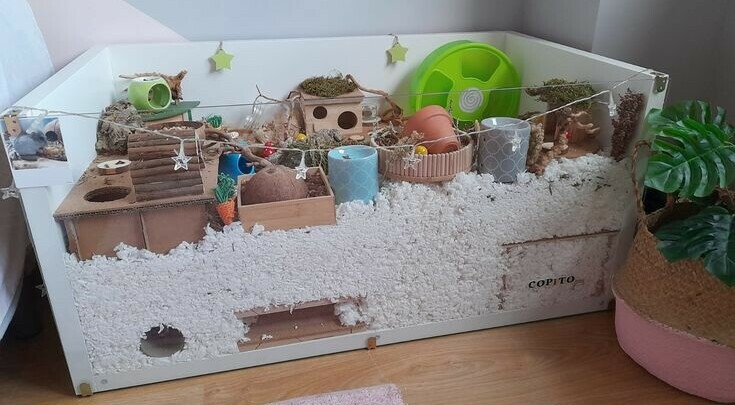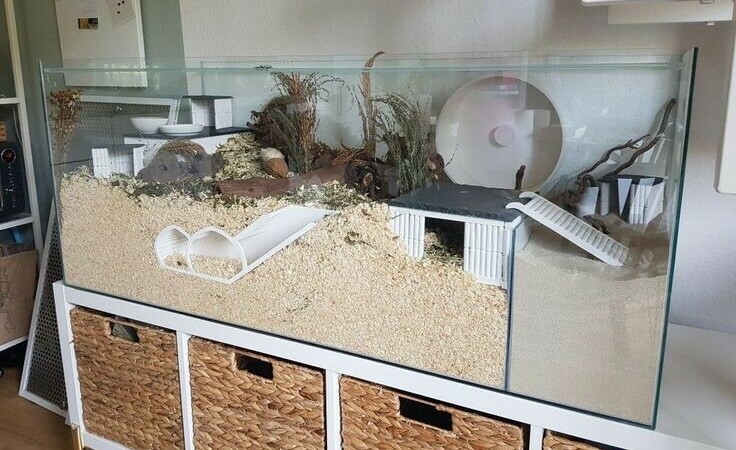I’m going to show you why picking the right cage for your furry friend isn’t just about the housing—it’s about ensuring they lead a joyous and robust life. The cage you choose is more than a structure; it is a home that profoundly affects their health, happiness, and behavior.
You’re going to find out about the intricacies of hamster behaviors and the interlinked effects of their environment on their quality of life. Hamsters, much like us, require personal space to thrive—a habitat that accommodates their need to run, stretch, burrow, and rest.
In my opinion, the right cage size matters immensely. Imagine being cooped up in a cramped space; not very pleasant, right? Same goes for these critters. That’s why the ‘ideal hamster cage size’ is not just a suggestion but an essential standard. For instance, a Syrian hamster needs at least 360 square inches of uninterrupted floor space, while dwarf hamsters require a slightly lower minimum of 288 square inches. Think of it as gifting your pet a private mini-world.
And this isn’t just about a wide floor area; ‘spacious hamster cages’ also mean providing room vertically for little climbers. However, don’t let the vertical space distract from the importance of the horizontal—it’s where the heart of their activities takes place.
Choose something that resonates with you and complies with these standards; it’ll make the following checklist (which we’re diving into next) a breeze to tackle. Remember, the goal here is a comfortable, enriching environment that fosters natural hamster behaviors and minimizes stress.
The Hamster Home Checklist: Key Factors for a Healthy Habitat
When it’s time to create a safe and comfortable space for your adorable furry friend, there are several crucial checkpoints to consider to ensure their health and happiness. Let’s zoom in on some of the most important features your hamster’s future home should have.
Bar spacing is vital for the safety of your hamster. For your Syrian hamster, the golden rule is to keep the bar spacing no wider than 1/2 inch to prevent any great escapes. And for those tiny dwarf hamsters? Keep to an even finer limit of 1/4 inch bar spacing. And it’s not just the spacing; we’re after durability and smooth finishes too, because rough edges or flimsy materials are no-nos where your pet’s safety is concerned.
Never underestimate the power of fresh air! Adequate ‘hamster cage ventilation’ is a non-negotiable attribute of a good home, to keep any unpleasant odors at bay and provide much-needed air circulation. Wire cages are typically aces at this, but if you go for a glass tank, just be sure it’s equipped with a mesh top or plenty of air holes.
And speaking of unpleasant odors, you’re going to want a cage that’s a breeze to clean. So, here’s where ‘ease of cleaning’ plays a starring role. Look for a design that allows you to easily reach in or dismantle parts of the cage when it’s time for that deep cleanse. Remember, ‘hamster cage cleaning tips’ often include having removable trays or bases for hassle-free maintenance.
Finally, let’s touch on materials. The market has a plethora of options, from wire, plastic, to glass. Each type comes with its perks and quirks. Wire is excellent for ventilation and visibility, plastic can be versatile in design (though it has to have good air flow), and glass provides a classy, clear view. But, hey, it’s heavyweight and could be a workout when cleaning time rolls around. And durability? That’s where ‘durable hamster cages’ come into play. You’ll want a cage that stands the test of time and the gnaw of those little teeth. Be on the lookout for ‘hamster cage materials’ that can take a bit of nibbling without falling apart.
Security is also at the forefront of ideal cage considerations. The doors, lids, and latches should be secure enough to withstand your furry escape artist. ‘Escape-proof hamster cages’ are not just a fancy term; they’re an essential investment in your hamster’s safety.
With those checkpoints in mind, you’ll be well on your way to creating a hamster habitat that goes beyond basic needs, fostering an environment where your pet can thrive. And as you move to the next section, think about how you’re not just putting together a cage, you’re curating a home full of accessories and opportunities for your hamster to truly enjoy life.

Creating a Dynamic Hamster Environment: Accessories and Setup
An ample and safe space is crucial, but there’s a lot more to a hamster’s home than just its walls. Now I’m going to shed light on how to turn a simple cage into a dynamic habitat that caters to your hamster’s needs for activity and amusement.
Choose something that resonates with you when picking out ‘hamster cage accessories’. Just don’t focus too much on perfection right away, because you can always adjust your approach down the road. To start, every hamster’s abode should come with a solid exercise wheel. It’s vital for their physical health to have one that’s size-appropriate – at least 8 inches for Syrian hamsters and 6.5 inches for the little dwarf varieties.
Incorporating ‘hamster cage setup ideas’ involves more than just accessories, it’s about creating an experience for your pet. Think about including tunnels, hideouts, and climbing structures. These additions are not just for fun; they’re a form of ‘hamster enrichment ideas’. Your little friend is naturally curious and will appreciate the opportunities to explore.
When it comes to nesting, the choice of substrate is key. A thick layer for burrowing encourages natural behavior. Choose materials like aspen shavings or paper-based options to ensure it’s safe and ‘dust-free’. Remember, the depth should be at least 2-3 inches to satisfy their digging instincts.
A good setup isn’t static. It should evolve with your hamster’s changing needs. Observe their behavior and make changes accordingly. Maybe add more tunnels or variate the bedding to keep things interesting. That’s part of the fun in caring for your hamster and ensures their environment remains engaging.

Sitting Pretty: Placing Your Hamster’s Cage for Maximum Comfort
Finally, where you place your hamster’s cage in your home is just as important as the cage itself. You want to choose a location that supports their health, happiness, and natural behaviors. First off, aim for a quiet, low-traffic area to reduce stress and noise levels \’— remember, hamsters are sensitive creatures who value their peace.
Temperature control can’t be overlooked. These little guys need an environment that’s neither too hot nor too cold. A consistent temperature between 65-75°F (18-24°C) is ideal, well away from potential drafts, direct sunlight, or other sources of extreme temperature change.
Social interaction can be a tricky balance. While you don’t want the cage in a noisy and busy spot, it’s good to position it somewhere you can regularly engage with your furry friend without intruding on their solitude. Ideally, you’re providing an opportunity for interaction that doesn’t overwhelm them.
In essence, when scouting the prime spot for your hamster’s home, consider these factors to create a serene haven. It’s not just about adhering to ‘hamster cage location tips’; it’s about observing your pet and understanding how they respond to their habitat. It’s these careful considerations that can make all the difference in your hamster’s life \’— contributing to a satisfied, healthy, and active companion.

I really hope that you find this guide useful as you create the perfect home for your hamster. Remember, their space is more than just a cage; it’s their universe. Paying attention to details like location, temperature, and social environment will make you the best hamster keeper. Don’t forget to mix in your personal touch with ‘hamster enrichment ideas’ and watch as your little friend flourishes in their well-appointed abode. If you have any of your own tips or experiences to share, your insights could be just what another hamster enthusiast needs to hear. So, pick the perfect spot, keep it comfy, and enjoy the happy, healthy energy that your hamster brings to your home.


2 replies on “Choosing The Right Cage For Your Hamster”
I agree that it is best to choose a cage with the bars closer together. I once made the mistake of getting wider bars for a bird cage and the bird kept getting its head stuck in the bars. The closer the better I think.
I love that you can make the cage look like a mini home and I am sure that the hamster can also keep himself amused with this sort of setup. It looks great and serves a function.
I would also look carefully at the location, as you don’t want your hamster to get sick if there is a constant draft on it, or too hot if it is in a sunny spot.
How big do you think a cage would need to be minimum for two hamsters?
Hey Michel, to answer this question for you when considering housing for two hamsters, it’s important to note that hamsters are generally solitary animals and can be territorial, especially Syrian hamsters. Syrian hamsters should always be housed alone to prevent fighting and stress. However, if you have a pair of dwarf hamsters, which are more social and can sometimes live together peacefully, you will need a spacious cage to minimize conflicts and provide ample space for each hamster.
For two dwarf hamsters, the minimum recommended cage size is at least 600 square inches of floor space (e.g., 40 inches by 15 inches). However, bigger is always better, as more space allows for additional enrichment and reduces the chances of territorial disputes.
In addition to a large floor space, the cage should have multiple hiding spots, separate feeding areas, and plenty of enrichment items like tunnels, wheels, and chew toys to keep them occupied and minimize stress. Regularly observe their behavior to ensure they are getting along well, and be prepared to separate them into individual cages if any signs of aggression or stress occur.
The location of your hamster cage is indeed also very important to ensure your hamster’s health and well-being. Hamsters are very sensitive to drafts, extreme temperatures, and sudden changes in their environment.
If you have any specific questions or need further advice on hamster care, please don’t hesitate to reach out.